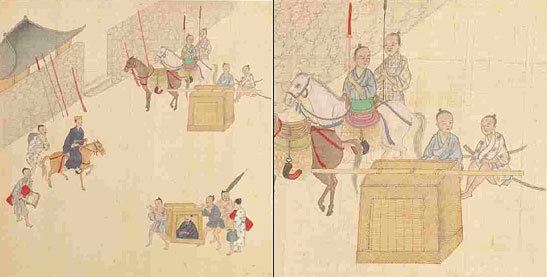Translator’s note: The Japanese language version of this article was published on the Motobu-ryū Blog. It was translated and published here by the courtesy of Motobu Naoki Shihan of the Motobu-ryū and Motobu Udun-dī. Any inadequacy is mine alone.
Paradigm and Perspective
Below can be seen one sheet from the “Complete Picture of Ryūkyū” (Liuqiu quantu 琉球全図) from the National Palace Museum Collections in Beijing. It shows the “Picture of Shoulder-Palanquin” (jianyu-tu 肩輿図), or in other words a Ryūkyūan palanquin (kago 駕籠). This picture mainly shows the palanquin and a group of retainers (tomo-mawari 供回り).

A wooden bearing shaft (nagae 轅) is attached on top of the roof of the palanquin depicted in this picture. In Ryūkyū this type was called Unānda 御安駄 (verbatim, “safe carry”) and used for persons of the social status of Sanshikan 三司官 and above.
In case of palanquins used by common “samurai” of Uēkata 親方 rank and below, the wooden bearing shaft (nagae 轅) passes through under the roof. These palanquins are called Ukagu 御駕籠. In this way the kinds of palanquins were distinguished according to social status.
Researchers of Okinawa studies and of karate history will probably be caught wide-eyed in surprise by the value of this painting. This is because the tomo-mawari retainers are depicted bearing weapons. Especially the two sitting attendants, who wear Japanese swords at their waists, perhaps uchigatana 打刀, however, worn in long sword (tachi 太刀) fashion with the blade (ha 刃) pointing downwards.
During the latter Muromachi period (1392–1573) this sword bearing fashion was called tenjinzashi (天神差し). On the other hand, the Japanese samurai of the later Edo period (1603–1867) usually bore their swords with the blade (ha 刃) pointing upwards.
This drawing has been on display in Okinawa for the first time ever in an exhibition in 2008 held at the Okinawa Prefectural Museum & Art Museum. It was an exhibit at the same exhibition as the previously introduced Ryūkyūan swords.
According to a commonly accepted theory of karate history that has been widely spread up to now, since yielding allegiance to Satsuma in 1609 the Ryūkyūan people are said to have been deprived of their weaponry by means of the “policy of military prohibition” (kinbu seisaku 禁武政策) and developed “karate” in order to combat the warriors (bushi 武士) of Satsuma with their bare hands.
However, with the exception of the firearms, possession of weapons in fact was not prohibited. When it comes to members of the upper class samurai (shizoku 士族), when going outside – especially during official visits to Shuri Castle – in this way the tomo-mawari retainers would carry swords and spears.
The number and types of weapons of the tomo-mawari retainers were strictly specified according to the social status.
In the Zhongshan Chuanyun-lu by Xu Baoguang (1719), the composition of the tomo-mawari retainers for all social stati is described in detail.
Until prior to the war these kinds of weapons were still kept in the homes of the former warrior families (shizoku 士族).
Mr. Gima Shinkin, a descendant of Gima Shinjō (1557–1644), bore witness as follows.
“Gima: Indeed, now that you mention it, in my family home also, [weapons such as] short spear, sword, short sword and the like were being preserved and I also recall a spear and sword in the family home (Tokuda family) of the mother of the official guard of the Royal Tea Villa (Uchaya-udun 御茶屋御殿).”
(From: Gima & Fujiwara 1986, page 44.)
Because during the Taishō period (1912–1926) Motobu Chōyū Sensei also showed Uehara Seikichi Sensei a knive (tantō 短刀), pole-sword (naginata 長刀), and spear (yari 槍) from his possession, it seems that these kinds of weapons were still preserved in the Motobu-udun 本部御殿 in those days.
I’m afraid to say the whereabouts thereafter are unknown. Probably they were destroyed by fire during the war.
The thing called “commonly accepted theory” is always defined by the value systems, concepts and norms that are characteristic to a certain era.
The framework of such a perception is referred to as paradigm.
And when such a paradigm is overturned, it is referred to as a paradigm shift.
Although paradigm is a term coined by Thomas Kuhn, a similar way of thinking was expressed by Friedrich Wilhelm Nietzsche with the term perspective.
Therefore, in the study of budō history it is necessary as well to begin to always scrutinize the commonly accepted theory, until by the presence of one sheet of a picture the commonly accepted theory and the known facts are overruled.
❁
Bibliography:
Yomigaeru Ryūkyū Ōkoku no Kagayaki: Chūgoku, Chūgoku Pekin Kokyū Hakubutsuin Hizō: Okinawa-kenritsu Hakubutsukan Bijutsukan Kaikan Isshūnen Kinen Hakubutsukan Tokubetsuden. Okinawa Prefectural Museum & Art Museum, 2008.
Gima Shinkin and Fujiwara Ryōzō: Taidan – Kindai Karate-dō no Rekishi wo kataru [Dialogue – Talking About the History of Modern Karate]. Bēsubōru Magajin-sha 1986.
Okinawa Daihyakka Jiten. Volume 1. Okinawa Taimususha, 1983. Entry about palanquins (Kago). p. 692
© 2016, Andreas Quast. All rights reserved.